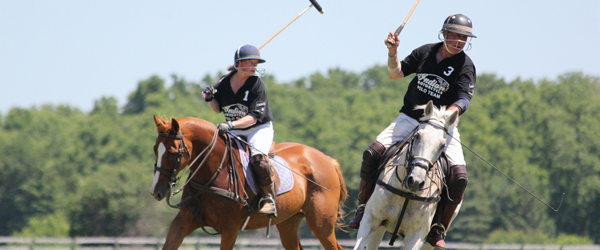 She likes to chew on her lead rope and occasionally this otherwise well-behaved mare will unplug the brake lights by disconnecting the the electrical cord between the truck and trailer. Then again, she once went by the name It’s All About Mary so it might be nothing more than a residual personality quirk.
She likes to chew on her lead rope and occasionally this otherwise well-behaved mare will unplug the brake lights by disconnecting the the electrical cord between the truck and trailer. Then again, she once went by the name It’s All About Mary so it might be nothing more than a residual personality quirk.
Now known simply as Mary, the eight-year-old left Canterbury Park four years ago to join the ranks of the polo ponies who chase a ball, rather than a frontrunner, around the grounds of the Twin Cities Polo Club in Maple Plain.
The transition is not as far fetched as it might seem. “Thoroughbreds make good polo horses because they’re used to running and bumping,” said Cathy DeGonda, who adopted Mary from the racetrack after giving up on a horse that wasn’t taking to the game.
For what it’s worth, there are other connections between racing and polo, too, as far back as 1876 when the first outdoor polo game in the U.S. was arranged by a group that included August Belmont and was played at the former Jerome Park Racetrack in New York, where the first runnings of the Belmont Stakes were also conducted.
The august Belmont was a promiment citizen of the area and the time, respected enough to have a racetrack named in his honor.
DeGonda is starting her 12th season of playing polo. A native of Minnetonka, she was on a trail ride with a girlfriend who started to play the game when the subject was broached. “I went to watch her play. I took a couple of lessons and was hooked,” DeGonda said. “That was it.”
The game of polo requires a participant to have a virtual remuda on hand, no fewer than three or four ponies and more if possible. Ideally a polo player has remount for each of the six chukkers (periods or quarters in other games) that make up a polo match.
“Typically to play a game you need at least three horses, if not more,” DeGonda said. Although the same horse can be used in two chukkers of a game, they need a solid rest before returning. A chukker consists of seven minutes of nearly constant stopping, starting and running. “Most people, after playing the game for awhile, will get six horses. Some will bring six or more to a game,” DeGonda added.
Which takes a real commitment and a large trailer, too.
It takes stamina and a propensity for running. “That’s why these thoroughbreds make good polo horses,” Gonda added. “They’re used to a lot of running.”
Mary, unlike DeGonda’s previous horse, was a natural at the game. “She was very calm and easy to teach,” DeGonda said. “I started working her lightly that first fall, rode her on a bunch of trail rides and even took her on a long fox hound hunt. The next spring I started training her.”
Mary not only took to the game but started displaying a real enjoyment for it.
“She loves playing polo. She loves chasing the ball,” DeGona explained.
Polo ponies play the game as young as three years old. “People will play them into their early 20s,” DeGonda added. “They start to slow down a bit about that age, but they know so much by then and they like the exercise.”
Getting a pony in condition to play polo is not unlike training for other equine athletic endeavors.
“We start walking , then trotting, then sets of trots,” DeGonda said. “We’ll do a couple of miles for two weeks or so and then go into cantering.”
Then the real practice begins. “We go out and start hitting the ball and chasing it.”
Mary is a chesnut, about 15.2 hands, with two white hind socks. She’s just about the right size for DeGonda. “You don’t want one so tall you can’t reach the ball with your mallet. I had one once about 16 hands, pretty tall but a terrific horse.”
Once DeGonda made the decision to part with her former horse, she worked out a trade deal, giving the horse to a friend of Canterbury’s state vet Lynn Hovda, who in turn found Mary for her.
Mary is eager to please and unbothered by much of anything, calm enough that an 11-year-old girl has used her to play polo. When the girl approaches her with the bridle, Mary will drop her head to make matters easier for the youngster.
All three of DeGonda’s polo ponies are former racehorses from Canterbury. She has Susie, who raced under the name “Playit,” and she has Boodini, whose name is unchanged.
“Each one has its own characteristics,” DeGonda said, although Mary has played the game more than the others and is a bit more experienced.
Don’t take Mary’s good-natured disposition for granted, either. She’s in charge of the paddock at the DeGonda farm. She runs the show.
“She’s bigger than the other two,” DeGonda added. “She’s the boss.”
This blog was written by Canterbury Staff Writer Jim Wells. Wells was a longtime sportswriter at the Pioneer Press and is a member of the Canterbury Park Hall of Fame.